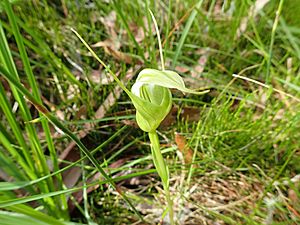Sickle greenhood facts for kids
Quick facts for kids Sickle greenhood |
|
|---|---|
 |
|
| Pterostylis falcata growing in swamp, Barrington Tops National Park | |
| Scientific classification | |
| Genus: |
Pterostylis
|
| Species: |
falcata
|
The Pterostylis falcata, also known as the sickle greenhood, is a special type of orchid. It grows naturally only in south-eastern Australia, meaning it is endemic to that area.
This plant has bright green leaves that grow in a circular pattern at its base, like a rose. It produces a single flower that is green and white and looks a bit like a sickle, which is a curved tool used for cutting. The sickle greenhood is very common in Victoria, but you can also find it in other parts of Australia, including Tasmania.
What Does the Sickle Greenhood Look Like?
The sickle greenhood is a plant that grows from the ground. It has an underground tuber, which is like a small storage organ. Each year, it grows new leaves and flowers, and then its leaves fall off.
- Leaves: The plant has three to six bright green leaves that form a rosette around the bottom of its stem. Each leaf is shaped like a spear or an egg, measuring about 30 to 80 millimeters (1.2 to 3.1 inches) long and 14 to 25 millimeters (0.55 to 0.98 inches) wide.
- Flower: A single flower grows on a stem that can be 150 to 300 millimeters (5.9 to 11.8 inches) tall. The flower itself is dark green and white, about 60 to 80 millimeters (2.4 to 3.1 inches) long and 20 to 24 millimeters (0.79 to 0.94 inches) wide.
- Flower Parts: The top part of the flower, called the dorsal sepal, and the petals are joined together to form a hood over the flower's central part, which is called the column. The dorsal sepal is much longer than the petals and tapers to a point. There's a wide space between this hood and the two lower sepals. These lower sepals stand upright and have narrow tips that are 30 to 40 millimeters (1.2 to 1.6 inches) long. They also have a deep V-shape between them.
- Labellum: The labellum is a special lip-like part of the flower. It is brown, curved, and measures about 25 to 34 millimeters (0.98 to 1.34 inches) long and 3 to 4 millimeters (0.12 to 0.16 inches) wide. About half of this labellum sticks out through the V-shaped gap in the lower sepals.
You can usually see these orchids flowering from September to February.
How Was the Sickle Greenhood Named?
The scientific name for this orchid, Pterostylis falcata, was first officially described in 1915 by a botanist named Richard Sanders Rogers. His description was published in a scientific paper called Proceedings of the Royal Society of Victoria.
The second part of its name, falcata, comes from a Latin word that means "curved like a sickle." This perfectly describes the unique shape of its flower!
Where Does the Sickle Greenhood Live?
The sickle greenhood grows in the south-eastern parts of Australia. It loves wet places, especially near small streams or creeks. Sometimes, its rosette of leaves can even be covered by flowing water!
While it's most common and widespread in Victoria, you can also find it in eastern New South Wales, the Australian Capital Territory, Queensland, South Australia, and Tasmania. However, in South Australia and Tasmania, it is considered an "endangered" species, meaning it's at risk of disappearing.

